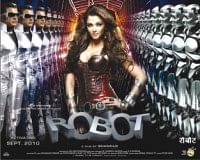Perceptions
From Hollywood to Bollywood
The Hybridisation of the Indian Film Industry
Anoushka Yousuf
"Dhoom again and run away with me on a roller coaster ride”. Now just add some hip thrusting, skimpy outfits, and eastern European dancers to the mix, and one has the equation for a hit Bollywood film. It's clearly obvious that Bollywood films have greatly globalised, and more specifically become westernised, in the past few decades. Everything from language, clothing, dance, music, and plot have been heavily influenced by the West and are a direct product of globalisation.
 In South Asia, globalisation has had a huge impact on culture, politics, and economy. The liberalisation of India in the 1990s allowed the country to be exposed to global products and ideas. The definition of globalisation is “a phenomenon by which the experience of everyday life, as influenced by the diffusion of commodities and ideas, reflects a standardisation of cultural expressions around the world. Propelled by the efficiency or appeal of wireless communications, electronic commerce, popular culture, and international travel, globalisation has been seen as a trend toward homogeneity that will eventually make human experience everywhere essentially the same” (Encyclopedia Britannica). Westernisation also has influence yet is different to globalisation as globalisation is bi-directional and will result in a hybridisation of both cultures and westernisation is unidirectional and the transition of ideas only travels from West to East and not vice versa. After World War II, westernisation became basically associated with Americanisation, as the United States became the cultural leader in the global world. In South Asia, globalisation has had a huge impact on culture, politics, and economy. The liberalisation of India in the 1990s allowed the country to be exposed to global products and ideas. The definition of globalisation is “a phenomenon by which the experience of everyday life, as influenced by the diffusion of commodities and ideas, reflects a standardisation of cultural expressions around the world. Propelled by the efficiency or appeal of wireless communications, electronic commerce, popular culture, and international travel, globalisation has been seen as a trend toward homogeneity that will eventually make human experience everywhere essentially the same” (Encyclopedia Britannica). Westernisation also has influence yet is different to globalisation as globalisation is bi-directional and will result in a hybridisation of both cultures and westernisation is unidirectional and the transition of ideas only travels from West to East and not vice versa. After World War II, westernisation became basically associated with Americanisation, as the United States became the cultural leader in the global world.
The Bollywood industry has a huge influence over Indian society and is a direct product of social, economic, historical, and political context. The industry produces 800-1000 films a year in many different languages thus making it a very global product. Bollywood films are such a success because of the broad audience appeal. The films interest the common man or the “janta” in Hindi as they provide an escape from their hard reality into a word of fantasy and fast paced narrative.
In the late 1970s, the English Language Press created the word “Bollywood” to represent the Indian Film industry. The industry was clearly affected by globalisation from the beginning, as the word “Bollywood” is a hybridisation of “Bombay” and “Hollywood”. Many may think that Bollywood is just being westernised, however globalisation is also occurring. For instance, the word entered the Oxford English Dictionary in 2001 and was therefore officially incorporated in westerners' vocabulary. Also more and more Indian films are being viewed in mainstream American movie theatres. For example, in the past 10 years, movies such as Bend it Like Beckham, Bride and Prejudice, and Slumdog Millionaire have been Bollywood inspired films made for an American audience. Each of these movies has been extremely well received in these western cultures where little was known before about Indian culture. It has even gone as far as a popular girl-band, The Pussycat Dolls, remixing the song Jai Ho, from Slumdog Millionaire and it playing on mainstream radio and a completely Hindi song winning an Oscar for best original song.
 |
A shot from Slumdog Millionaire. |
However, the transfer of ideas has even been more predominant from West to East, with an increasing amount of American influence arising in Bollywood films. The main reason for this is the escalating rate of migration and Diaspora communities. Indians are travelling to the west and bringing back with them ideas that they have encountered. There is also a great increase in media exposure to westernisation and more and more of the Indian society is being exposed to the entire global world. For the first time, technology is creating a link for Indians that allow them to see other cultures. Bollywood movies used to be based on Hindu myths and epics such as the Ramayana and Mahabharata but now Indian filmmakers are becoming inspired by American Hollywood movies (Gokulsing). They now “Indianise” Hollywood to fit the conventions of Indian Society. A filmmaker would Indianise by “adding emotions, expanding the narrative, and inserting songs”. Filmmakers have chosen to westernise their movies for one big reason: money. They want to increase their market and therefore are making more fast-paced movies to appeal to the “Janta” as slower and more traditional movies are geared towards an educated yet smaller and not as successful market. Diaspora communities are also valued audiences and investors therefore filmmakers would naturally want to shoot movies which relate to that audience. It would also be in the directors' best interest to film a movie that could easily be transitioned into the Western world as the US dollar and the English pound have a relatively higher value than the Indian rupee, and therefore ensure them a larger market and more profit.
Visually and audibly, one can easily notice the amount of western influence Bollywood movies now have. First of all, the plots of Bollywood movies have very much changed. There is an increasing amount of sexuality and visible displays of affections. In the past, it was unheard of a man, of a woman having a physical relationship before marriage and the characters were all very religious. To show affection, they would gaze into each other's eyes in the rain and a meaningful song would play in the background. However, now a days, there is more sexual content than ever. For example, in the film Dil To Pagal Hai , Madhuri Dixit and Shahrukh Khan after a party scene go back home and there is an implication of having premarital sex, a concept which would have been unheard of before . One can even witness European countries as backdrops in a scene. More and more Bollywood movies have their characters travel to locations such as England, Amsterdam, France, and the United States, which allows more exposure for audiences to see western people, trends, and culture. Finally, with Western influence, Bollywood movies are marketed differently. Billboards show men and women in provocative poses. Trailers for movies show clips of scantily clad actresses, provocative dance moves, and edgy music. In addition, the English Language has become more prominent in trailers. For example, the trailer for Dhoom 2 has Abhishek Bachchan saying more English words than Hindi and the English words “Back in Action” flash on the screen. What's more interesting is that the Indian audience completely accepted this westernisation and Dhoom 2 ended up being a complete blockbuster in India.
Clothing and costumes have also transitioned into a more westernised style as one can find girls in short miniskirts with heavy make-up, and men in muscle shirts with Nike shoes. A younger character who would represent a more modern upcoming India would wear this ensemble. A perfect example would be Kareena Kapoor in Kabhi Khushi Kabhie Gham, where she wears hot pants and a midriff top for the majority of the movie. The only characters who wear the traditional saris are the mother or aunties who are usually the more submissive characters. Therefore submission in India is starting to be aligned with traditional dresses.
Perhaps one of the more obvious products of hybridisation is the famous Bollywood song and dance routine. The average amount of songs in an Indian film is 6 or 7, and is usually the selling point of the movie. Before, music used to fall into a specific category such as classical, religious, or folk. However movies are now adding in Western influence to these genres and adding rapping, faster beats, reggae, and remixes. Songs, as well as just dialogue, in Bollywood movies are having an increasing amount of “Hinglish”. For example, in the song “Dhoom Again” from Dhoom 2, an excerpt from the lyrics go as follows; “Dhoom again and see your wildest dreams slowly come alive”. This is a clear instance of “Hinglish” where mid-sentence; the language changes from Hindi to English. Dance moves have also been westernised and over sexualised. While Hrithik Roshan sings “Dhoom again”, the choreographed dances accompanies the Americanised style with hip trusts and other suggestive gestures.
While Hollywood is entering a recession, the Bollywood industry is booming and shows little signs of slowing down. It is predicted that the industry should double in the next five years, while its American counterpart will be lucky to even receive a portion of that success. With the world becoming more globalised than ever, the amount of westernised substance found in Indian films will only increase. Bollywood is a 2.4 billion dollar a year industry and having audiences reaching across the globe, it is obviously apparent that the industry has tremendous influential power over society. Not only will Bollywood impact the amount of exposure to westernised culture, but also influence the way Indians act and think; it will revolutionise the Indian way of life.
Copyright
(R) thedailystar.net 2010 |
| |
